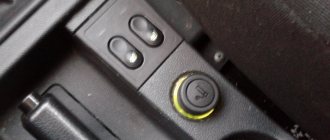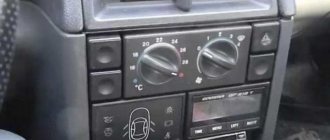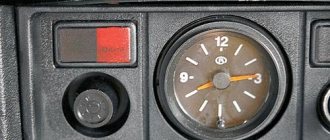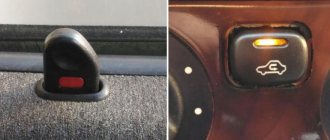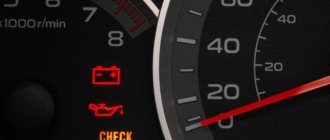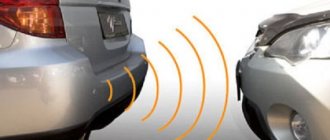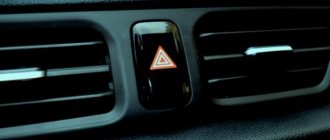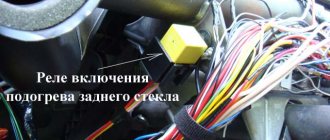VAZ sound signal does not work
A non-functioning horn on a car is a very dangerous malfunction.
The most unpleasant thing is that they find out about this breakdown just when the signal is needed most - in a dangerous situation on the road. What could cause the signal to fail? There are several reasons why the horn may stop working. Almost all of them are electrical and simply involve no contact where it should be. Let's go through them all:
Horn fuse blown
The very first and easiest check that can be performed when the sound signal is not working is the integrity of the fuse. If it turns out to be burnt out, then there may be a short circuit in the car. Try inserting a whole fuse that matches the rating (How to choose a fuse. Colors and ratings). If it burns out in the same way, it means there is actually a short circuit. If not, then perhaps the fuse has simply exhausted its resource and you should pay attention to other reasons.
The horn button does not work
The signal in most cars is turned on by a button in the center of the steering wheel. There are variations with a button in the steering column switch or a certain position of this switch itself, but this is rare.
There are actually a whole bunch of places inside the steering wheel where contact can be lost, leading to the failure of the horn. To understand exactly where they can be located, you need to understand how the sound signal in the car turns on. Let's look at the diagram.
Diagram for connecting an audio signal via a relay
This circuit assumes the presence of a signal activation relay. This relay is found on all modern cars. On a certain category of cars (for example, VAZ classics), there is no relay. In this case, the signal is connected directly through the button on the steering wheel.
The diagram shows that there are two electrical circuits: control and power. The power circuit feeds the signal and does not come into the car interior; the control circuit, on the contrary, comes to the steering wheel. When you press the signal button, the control contacts of the relay close, connect the power circuit and the signal turns on. What are relays, control and power contacts, read the article: how a relay works in a car .
The control current from the relay is transmitted from the steering column to the steering wheel through a floating contact. There may be one, or maybe two. These contacts rub against a special conductive ring built into the steering wheel at the point where it is attached to the steering shaft. Due to the fact that the contacts are spring-loaded, they are constantly pressed against the ring, ensuring the transmission of current to the steering wheel in any position.
Then the voltage is transmitted through a short wire to the button and when it is pressed, the electrical circuit closes to ground - the signal turns on. Now about malfunctions that can occur in the steering wheel.
ATTENTION!
It is better to entrust all work related to disassembling the steering wheel on cars with airbags to a car service center. Unskilled actions can cause the airbag to deploy, which can lead to life-threatening injuries!
– Worn contacts
The pressure contacts on the steering column rub against the slip ring whenever you move the steering wheel and wear out over time. Sooner or later, a moment may come when they can no longer reach the contact ring on the steering wheel and then pressing the horn button will lead to nothing. To avoid this, when removing the steering wheel for any repairs, it is necessary to lubricate the contacts and the ring on the steering wheel with a conductive lubricant, for example, graphite. Such treatment will reduce the friction of the contacts on the ring and extend their service life.
FakeHeader
That's it, the mechanical part is over, let's move on to the electrical part. As a rule, the horn device is located behind the engine radiator grille, directly in front of the main radiator device. As practice shows, often the cause of failure lies in their oxidation, so it makes sense to clean the contacts. Already crimped wires with terminals are sold in stores.
Using this circuit, you can connect almost any powerful device and control it with a small, beautiful key. I planned to do it from the front, instead of the standard one, but I couldn’t unscrew the grille mounting bolts. Connecting an air signal If you need to connect not an electric, but an air sound signal, the connection procedure will be almost the same as described above.
To do this, you will need to dismantle the relay and set the resistance measurement mode on the multimeter. The difference is that the wire from the relay does not go to the sound signal itself, but to the compressor engine, which supplies air to the signal. We mark the corner at the installation location, saw it off, and drill holes for attaching signals from the Volga.
This petal may burst over time; sometimes the cause should be sought in the jamming of the pressure rack. So we bring to your attention a diagram for connecting an audio signal through a relay. It is universal for most cars, with the exception of those cases when audio signals are used that receive mass through the body, for example Volgov's, for which the diagram is slightly different.
That's it, the mechanical part is over, let's move on to the electrical part. (easy and fast) Volgov Signals on VAZ 2107
Where is the signal located on a VAZ-2107 car?
The domestic automaker is releasing to the market several modifications of the VAZ-2107 car model, which is beloved by consumers. The design and location of each of them has a number of its own features:
- in some versions of the car, only one sound signal is used, which is mounted immediately behind the front lining of the cooling radiator. In this case, you can easily reach the part and replace it if the need arises;
- A number of modifications are equipped with two sound signals at once. They are installed directly behind the radiator and have different tones, which makes it possible to quite loudly warn pedestrians and drivers of other cars about the possible danger of a collision.
The RS-528 sound signal relay is mounted in the mounting block of both machines, which is often one of the main causes of breakdowns of this part.
In addition, the circuit can include fuse F7, which prevents the supply of excessively high voltage and its surges, as well as a button located directly on the steering wheel.
Checking the functionality of the relay and fuse
What to do if the signal on a VAZ-2107 car does not work, and for what reasons can it fail?
The most common one is a blown fuse. Under increased load, it fails and interrupts the electrical circuit, thereby eliminating more serious emergency situations. If you are faced with the problem of a blown fuse, you must replace it immediately. In addition, you will need to carefully inspect the contacts of this part, carefully clean them of carbon deposits and dirt, or perform repairs.
The next stage of diagnostics is to check the functionality of the sound signal relay. If it clicks when you press the button, then the cause of the breakdown needs to be looked for elsewhere. Otherwise, the relay will need to be replaced, which can be done within a few minutes even without the relevant experience.
Sound signal device for VAZ 2107
VAZ 2107 cars are equipped, depending on the year of manufacture, with two versions of the sound alarm. On models since 2000, a sound signal is installed on the VAZ 2107, consisting of two separate devices. One source produces low tones, and the second high. The devices are fixed directly to special brackets and are located on the left side of the radiator, under the grille.
Early models of VAZ 2107 cars are equipped with non-separable sound emission sources that produce only one tone. The product is also mounted on the front part near the radiator. The connection diagram of the element is simple, and in case of failure, eliminating the damage will not be difficult.
The sound signal device for 2 sources has the following form:
- Two wires are connected to the source of sound creation. One of the wires is red and the other is black. The red wire is the positive contact, which is constantly energized with 12V.
- The second wire is “minus” - it is de-energized and turns on only when the contacts are closed. As soon as the contacts are connected, current is supplied to the equipment, thereby generating sound vibrations.
The contacts are located on the steering wheel, and when you press the button, they close. Springs with a slip ring are used as contacts. The contact ring is located on the back of the steering wheel and provides high-quality contact when pressing the button. In addition to sources and a button, the design of the VAZ 2107 sound alarm also includes a relay and a fuse. The relay is designed to reduce the amount of current flowing to the device button.
The current level is also monitored by fuse F7, located in the circuit. The size of the fusible link is 20A for injection sevens, as well as 16A for carburetor old versions of the VAZ 2107.
This is interesting! At the same time, the cooling fan is turned on in the sound signal circuit, so frequent problems with blown fuses are an occupational “disease” in sevens.
Malfunctions of the sound signal of the seven
The causes of sound signal malfunctions on the seven are of three types:
- The AP stopped working completely.
- The sound appears when you press the button, but it is weak and hoarse.
- Spontaneous operation of the device.
Each breakdown has its own main causes, so we will consider them in detail.
Weak or unnatural sound
When operating a VAZ 2107, owners are faced with a malfunction such as a weakening of the signal sound. The sound becomes hoarse, intermittent and very quiet. Many car owners are guilty of the fact that the cause of this breakdown is clogging of the membrane with debris, as well as corrosive effects. The problem can be solved by cleaning, but since the device is of a non-separable type, it is impossible to clean it inside.
To check the health of the device, it must be directly connected to the battery. There is an adjustment screw on the device body, so if the signal does not work, adjustment can help. If the membrane is damaged, then only replacing the horn on the seven will save you.
Relay and fuse malfunctions
First of all, if when you press the signal button, there are no signs of its operation, then the test must begin directly with the fuse. As noted above, on sevens the horn fuse is a professional “sore”.
To make sure that the fuse is the cause, it should be checked first. Using a multimeter, the element is tested. Often a device malfunction can be identified visually. The fuse protects the wires from overheating. At the same time, it protects not only the alarm circuit, but also the cooling fan motor.
If you often have to change a blown fuse, you can increase its rating to 25A.
To find the fusible element, you will need to open the fuse box. If the fuse element is intact, then you also need to check the relay. It fails less often, but it doesn’t hurt to make sure it’s working once again.
Signal interchangeability
If the alarm device cannot be repaired, it must be replaced with another one.
All modern horns can be divided into two types: pneumatic and electromagnetic (video author - Russia 24).
In the first type of sound signals, the air flow moves from the compressor through a pipe, which, under the influence of vibration, begins to make sounds. Pneumatic devices differ in the shape of the tube and the power of sound. The frequency range of the audio signal covers several audio zones. Several pipes can be installed, but they require a powerful compressor.
The operation of an electromagnetic device is based on an electromagnet, which is connected to the main element of a horn of this type, a membrane. The core winding is connected to a power source (battery) using a breaker. The horn button is connected to ground. When you press it, the core rod begins to move, thus exerting an effect on the membrane. The result is a powerful sound.
Electromagnetic horns differ in the design of the sound emitter:
- Disc horns (“pancakes”). They are manufactured in two versions: non-separable and collapsible. In addition, it can be closed or open.
- Snail sounds. They are curved, making them difficult to install. The open end of the socket should point forward. “Snails” make it possible to get a very loud sound.
- Horns have a tube that looks like a straightened snail. Outwardly they look like a horn or a trumpet. They are convenient to install under the hood, but their sound power is weak.
Pneumatic type horn
Disk signal
Horns and horns
When choosing a sound device, you should pay attention to several nuances:
- Before purchasing, you should evaluate the capabilities of the battery. It is important that its charge is sufficient to power the buzzer, as it consumes a large amount of energy.
- You should check with the seller whether the horn needs additional power or a compressor.
- High frequencies produce a subtle sound. Low frequencies are suitable for bass lovers.
- It must be remembered that trucks have a 24 V on-board network, and passenger cars have 12 V. It should be noted that the use of “quacks” and special signals is prohibited.
We diagnose the signal and its activation buttons
In order to find out whether your car uses a correctly working signal, you should disconnect its wires from the relay and connect them directly to the battery. If the sound does not appear in this case, the causes of the breakdown may be the following:
- contacts located directly in the device body are burnt or heavily soiled;
- The signal is not configured correctly, causing the dial tone to sound very low or not audible at all.
Troubleshooting is done by adjusting the signal (to do this you just need to turn a special screw installed in the back of the case) and cleaning the contacts.
Another reason why the signal may not work is a broken or worn button. To restore its normal functioning, you can either replace the entire part, or again put the contacts to which the wires are connected in perfect order.
As you can see, you don’t have to go to a car service center to diagnose and repair the sound signal. Almost any work can be easily done with your own hands without spending a lot of time on it. We only strongly recommend that you do not delay this, so as not to expose yourself to the risk of a traffic accident due to a non-functioning horn.
